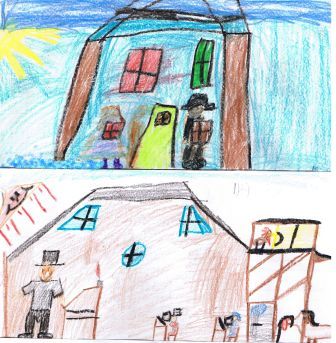 South Kingstown’s elementary students were riveted by a sweeping account of Narragansett Bay’s history in November. Capers Jones, member of New England’s Antiquities Research Association and author of The History and Future of Narragansett Bay, brought an extraordinary array of facts, figures and images spanning the origins of the bay through to the present day. Under the aegis of the district’s pilot Community Learning Project, the vivid presentation enabled students to project themselves back—way back—through the ages with ease and pronounced enthusiasm.
South Kingstown’s elementary students were riveted by a sweeping account of Narragansett Bay’s history in November. Capers Jones, member of New England’s Antiquities Research Association and author of The History and Future of Narragansett Bay, brought an extraordinary array of facts, figures and images spanning the origins of the bay through to the present day. Under the aegis of the district’s pilot Community Learning Project, the vivid presentation enabled students to project themselves back—way back—through the ages with ease and pronounced enthusiasm.Until 15,000 years ago, Rhode Island was covered by glaciers between 500 and 5,000 feet thick. When the ice melted, the bay became a freshwater lake spanning Providence to Block Island. Low shrubs and evergreens grew in sheltered places and fish thronged the bay, streams, and ponds in a climate too cold for trees, mammals, or year-round settlements.

Animals that evolved in the cold of 8,000 years ago include the short-faced bear, large dire wolf, outsized American lion, saber-tooth tiger, giant beaver, wooly mammoth, and the great auk. The chipmunk, because it could live closer to glaciers, remains the only animal still around on our shores today.
 Human history dates back 10,000 years as evidenced by local Native American artifacts. There also may have been European explorers as of 1,000 years ago; the first European visitor was confirmed in 1524. Early stone circles and structures now serve as local landmarks, like the Newport Tower, which remains a mystery as to when and why it was built. Notable local historical figures include Matthew Perry, treaty signer; Oliver Hazard Perry, naval commander, Thomas Lincoln Casey, monument designer; Anne Hutchinson, founder of Portsmouth; and Gilbert Stuart, portrait painter.
Human history dates back 10,000 years as evidenced by local Native American artifacts. There also may have been European explorers as of 1,000 years ago; the first European visitor was confirmed in 1524. Early stone circles and structures now serve as local landmarks, like the Newport Tower, which remains a mystery as to when and why it was built. Notable local historical figures include Matthew Perry, treaty signer; Oliver Hazard Perry, naval commander, Thomas Lincoln Casey, monument designer; Anne Hutchinson, founder of Portsmouth; and Gilbert Stuart, portrait painter.Encouraged to learn more about Narragansett Bay history, students were reminded of the wealth of opportunities nearby, including the Pequot, South County, and Herreshoff museums, and Smith's Castle.

When asked what they would like to have seen or done if transported back 10,000 years, the 1st through 5th graders expressed the gamut of practical possibilities. (And some, naturally, the improbable—but with impeccable use of the subjunctive.)
— “I would take chipmunks as pets. Why? Because they are so cute and I want to learn and observe the chipmunks.” [2nd grade—Carroll]
 — “I would make shelter and find food and look for animals and make a fire.” [2nd grade—Carroll]
— “I would make shelter and find food and look for animals and make a fire.” [2nd grade—Carroll]— “I would figure out what caused the weir to be there. I would also take pictures of the animals.” [3rd grade—Fogarty]
— “I would try to find a cave so I could live in it. If there wasn’t
 a cave, I would build a house out of wood.” [3rd grade—Fogarty]
a cave, I would build a house out of wood.” [3rd grade—Fogarty]— “I would want to hunt a saber-toothed tiger. I would want to build something that would be really cool like a huge stone building.” [3rd grade—Heid]
— “I would make a tree-house city for me to live in.” [3rd grade—Masson]
— “I think I would take photographs of animals like the saber-toothed tiger or the Native American lion! And lots more…” [3rd grade—Masson]
 — “I’d study the plant and animal life that inhabited the land.” [4th grade—Cole]
— “I’d study the plant and animal life that inhabited the land.” [4th grade—Cole]— “A dolmen is a big rock. I would stand on it and try to hunt a wooly mammoth for food. There were also smaller rocks on the bottom of the dolmen.” [5th grade—DeFeo]
— “…I would make a hut. Then I would fish and hunt animals then I would use the animals’ fur for clothing and blankets and other things that I use now.” [5th grade—DeFeo]
— “I would try to build shelter and build rock walls in the water to get fish. I would build bows and arrows and make furs to put on.” [5th grade—DeFeo]

— “I would make a shelter, fire, get food, and then I would make tools to hunt and survive.” [5th grade—DeFeo]
By Jon Pincince & Rian Smith





No comments:
Post a Comment